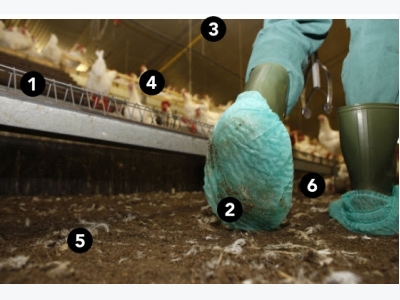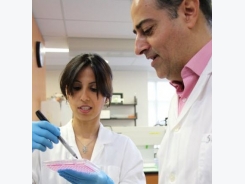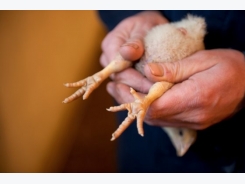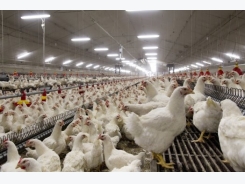12 ways to eliminate odour on poultry farms

Keeping a tight lid on smell is one of the primary responsibilities of the poultry farm manager.
Photo: Hans Prinsen
Statutory authorities have a duty to deal with odour complaints from a variety of sources, including poultry farming.
In particular, they are obliged to investigate cases where they are thought to be causing a “statutory nuisance”, defined as “any smell arising on industrial, trade or business premises that is prejudicial to health or a nuisance”.
Although sometimes difficult to measure, such smells can result in enforcement action and ultimately prosecution, so any activities that are potentially odourous should have procedures in place to reduce the risk.
There are a number of odourous gases related to poultry farming, including mercaptan, hydrogen sulphide, skatole, thiocresol and thiophenol.
But the main culprit in odour complaints is ammonia (NH3) – a colourless gas with a very sharp smell. As well as being harsh on the nose, ammonia is also an irritant and corrosive, and exposure to even low concentrations may produce rapid skin or eye irritation.
And since ammonia is lighter than air, it disperses easily. Unlike other denser compounds, it will not settle in low-lying areas.
Minimise emissions
The main sources of odour from a poultry farm are considered to be livestock, feed, housing, manure and waste (including carcasses), and these are closely monitored by the Environment Agency.
Together with the British Egg Industry Council, the British Poultry Council and the NFU, it has produced a number of publications and checklists which specify the sources and various actions poultry farmers can take to minimise emissions from their holdings.
Mitigation methods are usually site specific and will vary depending on the scale, location and type of poultry farming being undertaken. But 2 aspects that are common to all are good housekeeping and effective monitoring.
“Sniff testing” around poultry units will help determine the intensity of the odour, and this can be supported using a field olfactometer for routine monitoring. If such results are inconclusive, then a more robust laboratory analysis can be carried out.
Using additives to mask odours
Where necessary the use of additives to mask an odour for a particular operation, for example the transfer of manure, can be considered, though this is not a long-term solution and the masking odour itself can equally lead to complaints.
If an operator is planning on developing a new poultry farm, consideration should be given to the design of the building, in order to minimising odour emissions. For example, having a second wall at the end of the shed, to slow air flow and let dust settle, can be effective.
Odour modelling can also provide an indication as to whether the proposed new building is likely to result in a nuisance.

Photo: Peter Roek
How to minimise odour from poultry farms
1 - Feed
Clean up spillages, avoid fine grinding of feed, reduce protein content of feed and consider using feed additives.
2 - Litter and manures
Control humidity and temperature, force air dry layer manure, frequently empty manure belts (once or twice weekly), locate manure storage away from sensitive receptors, consider storage location in relation to prevailing wind direction, maintain bird health, provide sufficient straw/litter to bind nitrogen and prevent ammonia escaping.
3 - Ventilation
Ensure ventilation is adequate for the scale of the farm, extract air via roof vents (release from height assists with the dispersion of odours), use increased fan velocity away from sensitive receptors and clean ventilation discharge points regularly.
4 - Catching/destocking
Ensure doors are kept closed or catching curtains used before the birds are actually removed, and park vehicles away from sensitive receptors.
5 - Spent litter/manure
Transfer to trucks in a contained area if not stored on site and keep vehicles/trailers covered unless loading.
6 - Carcasses
Collect frequently, store away from sensitive receptors and cover carcasses where possible.
7 - Infrastructure
Maintain buildings to ensure integrity, use landscaping, trees and banking to create barriers
8 - Dust
Avoid build up at any location, minimise dust emissions from buildings and frequently clean dust from the ventilation outlets.
9 - Monitoring
Weather stations should be installed to provide information on prevailing wind direction. Record shed humidity, monitor all complaints and conduct checks of the surrounding area with someone who does not regularly work on the farm. Ask neighbours for their views and record comments.
10 - Contingencies
Conduct daily checks to detect abnormally high housekeeping odours, disease and plan for staff unavailability.
11 - Land spreading of manure
Plan timings for spreading not on weekends or public holidays, consider wind direction and location of sensitive receptors, treat manure (if required). Odours can be detected up to 3km from the field. If necessary, develop a Manure Management Plan.
12 - Dirty water management
Have a contained water collection system, maintain drains and concrete areas and promptly clear dirty water as part of cleaning the building.
Source: NFU, BEIC and BPC’s “Poultry Industry Good Practice Checklist” and Environment Agency’s guidance note “How to comply with your environmental permit for intensive farming”.
Nicole Walker is a senior environmental consultant at Midlands-based consultancy firm, Crestwood Environmental.
Có thể bạn quan tâm
Phần mềm

Phối trộn thức ăn chăn nuôi

Pha dung dịch thủy canh

Định mức cho tôm ăn

Phối trộn phân bón NPK

Xác định tỷ lệ tôm sống

Chuyển đổi đơn vị phân bón

Xác định công suất sục khí

Chuyển đổi đơn vị tôm

Tính diện tích nhà kính

Tính thể tích ao hồ




 Gut health and immunity key in antibiotic-free poultry…
Gut health and immunity key in antibiotic-free poultry…  Artificial peptide molecules can inhibit AI virus strains
Artificial peptide molecules can inhibit AI virus strains